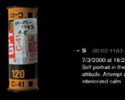The latent image is the invisible image, it is the image of light engraved on traditional photographic material. Technically speaking it is the image-to-become when developed in photographic emulsion. The stability of the latent image is limited, so that it might vanish if it does not get exposed. (see wikipedia)
According to the work of Joana Hadjithomas and Khalil Joreige …
| Latency is the state of what exsists in a non-apparent manner, but which can manifest itself at any given moment. It is the time elapsed between the stimuli and the corresponding response. The latent image is the invisible, yet-to-be- developed image on an impressed surface. The idea is that of the ‘dormant’ – slumber, slumbering – like something asleep, which might awake at any moment. |  Latent images from Wonder Beirut, 1998-2006, Contact sheet. Film no 00-03-1183RE, March 6-9, 2000; Self portrait in search of impassive attitude |
| Latency has connotations with essence, but also with the idea of the repressed, the hidden, the unstable, of an invisible element. It is an obscure form, troubling because it cannot be delineated; it is not a defined territory, but a diffused state, uncontrollable, underground, as if lurking, as if all could resurface again. …. (from Homeworks, Latency link) | |
A different form to deal with invisibilty / disappearance and to represent the moment between fiction and truth has been developed by Rabih Mroué. In his early performance ‘Three posters‘ (together with Elias Khoury) he plays as a performer, who almost always stays outside the field of vision of the audience whilst he talked about issues such as the suicide operations carried out by members of the Lebanese communist party against the Israeli occupation (excerpted from On theatrical acts: a matter of words and distance, Lina Saneh).
He continues this form of performative absence even more radical in a newer project titled the ‘Looking for a Missing Employee‘, where the actor takes up entirely the form of the absent image on stage itself.
| Rabih Mroué looks at disappearance as one of the “signs of modernity” (!), meaning a sort of escapism, an escape through the thin cracks in the burden of the hegemony of communities. He says that his interests lies in the phenomenon of disappearance as a suspended existence, as the “death of the |  |
| idea but not of the body”; when the individual “exists and does not exist at the same time, when he is both alive and not alive (…), absent but perhaps coming back”, which implies and imposes the renewed adjournment of everything, even that of tears… (link) | |
Interview: Look for a missing actor with Rabih Mroué.
